Ireland invites you. Ireland invites you to discover and linger. To travel through the country without a destination and stop wherever your eye wants to linger. One of these places for me was Tintern Abbey….
Page Contents (click line to jump the text)
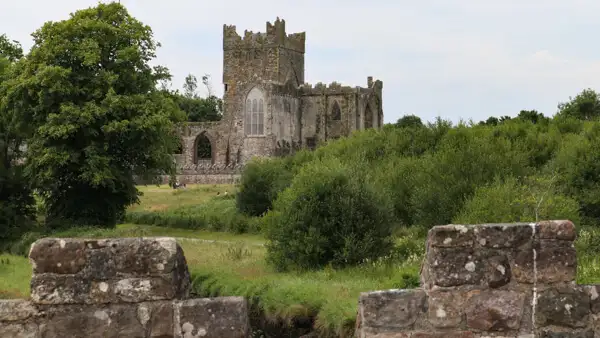
Intro
Tintern Abbey, or Tinternparva Abbey, is located in the south-west of County Wexford. This in turn lies in the south-east of Ireland. Here, on the edge of the Hook Peninsula, life is rural and tranquil.
A small stream meanders through the meadows and flows into a sandy bay, Bannow Bay, which in turn flows into the sea after several sandbanks. Seabirds go about their business, more so than people, of whom there are not too many to be seen.
Visitors pass through here at the weekend on their way to Hook Lighthouse. And there are a few holiday homes on the beautiful peninsula. But mostly there’s not much going on here.
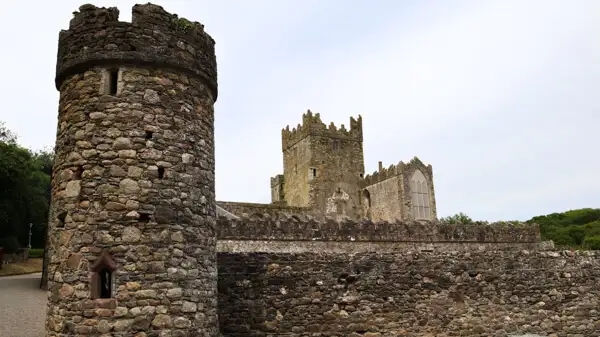
I’ve been to the area several times, as we have our second home not far from here. I’ve usually just driven through. But today we’re stopping off. My wife and I are going on a motorbike trip and want to stretch our legs for a while. We don’t usually have any particular interest in church sights. But today we want to take at least a quick look at the monastery ruins.
The quick look takes a good hour. Why? The place invites you to linger, to stroll, to discover and to stroll – just romantic…
Some background about Tintern Abbey
However, the abbey was built long before the Romantic period, around the year 1200, when William Marshal, an Anglo-Norman nobleman, ruled over large areas of land from Kilkenny to here, on the coast. He had a great influence on the founding and expansion of the city of Kilkenny, the castle of Kilkenny at that time, but also the Hook Lighthouse.
At this location, at the foot of the Hook Peninsula, he had this monastery built, modelled on Tintern Abbey in Wales. Legend has it that he was caught in a heavy storm while travelling by ship, prayed to God for a good outcome to the voyage and promised an abbey in return. God spared the ship and Marshal fulfilled his promise.
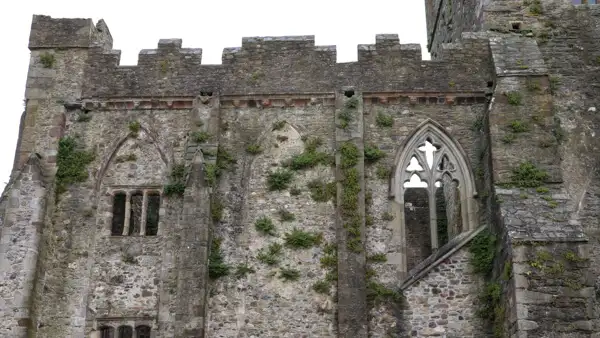
The Cistercian order from Tintern Abbey in Wales also settled here. The abbey quickly grew in importance and was granted large estates. It later became one of the wealthiest abbeys in Ireland, but was dissolved in the middle of the 16th century and granted to a nobleman.
The abbey was subsequently converted into a residence and in the 18th century the surrounding wall with towers was added.
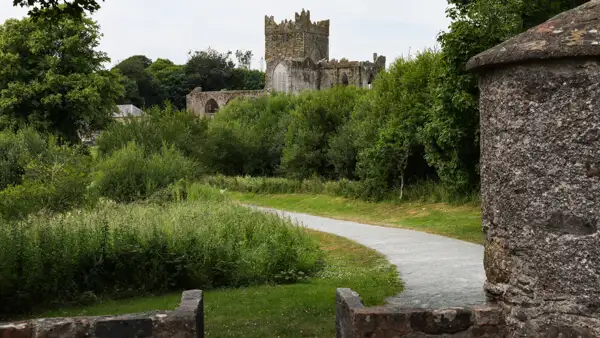
Visiting Tintern Abbey
It has been managed by the Irish state since the 1960s and is open to visitors from March to November. See: https://heritageireland.ie/places-to-visit/tintern-abbey/.
You can walk around the monastery buildings or take a guided tour inside the church and tower. A short distance from the church building you will find other outbuildings and the aforementioned walls and turrets. Follow the stream a little way to Tintern Bridge, the short walk is very beautiful.
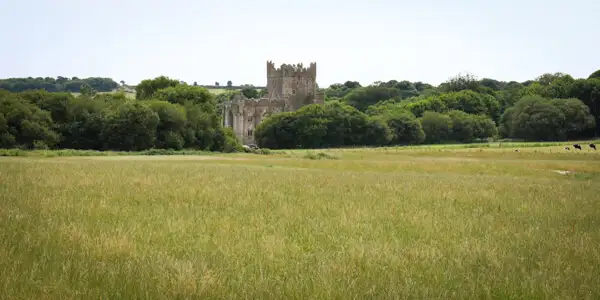
You could follow the path even further, all the way to the village of Saltmills. But the Colclough Garden is certainly more interesting. This is the former walled garden of the monastery, where fruit, vegetables and herbs were grown for the monastery – and today also flowers. It is located a little to the west of Tintern Bridge and can be reached from there via a forest path.
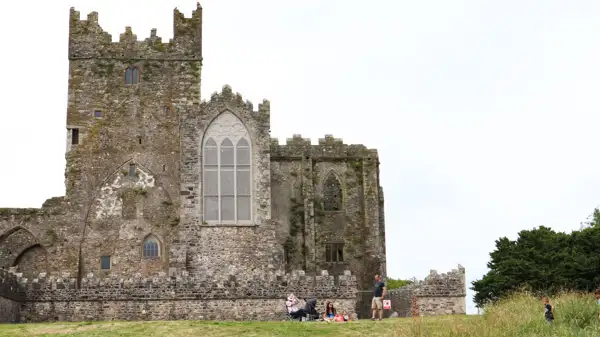
What else you can see in the area
You should definitely continue to the southern tip of the Hook Peninsula, to Hook Head Lighthouse. This is the oldest working lighthouse in the world! And the landscape there is simply marvellous. Click here for my article: https://ireland-insider.com/hook-head-lighthouse-the-oldest-active-lighthouse-in-the-world/.
Kilmore Quay is also a very nice place nearby. It’s a pretty little fishing harbour and you can still find reed-roofed cottages in the village. You can also visit: http://visitkilmorequay.ie.
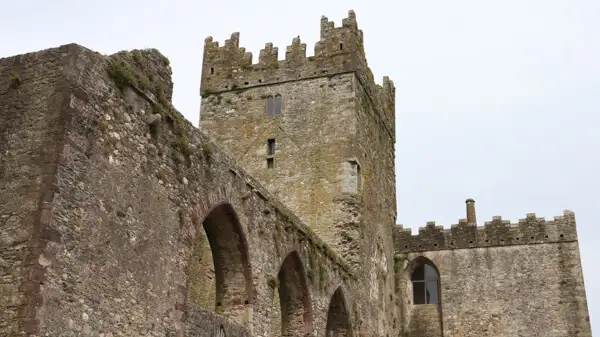
Wexford is a lovely town with a beautiful harbour and a cosy pedestrian zone that invites you to stroll and eat. See my article: https://ireland-insider.com/wexford-so-old-so-new/.
Waterford (like Wexford) is a city that was founded by Vikings. You can find out more in the Viking Triangle at the harbour. From Tintern Abbey, you can take the ferry from Ballyhack to Passage East to get to Waterford. See my article: https://ireland-insider.com/waterford-and-the-vikings/.
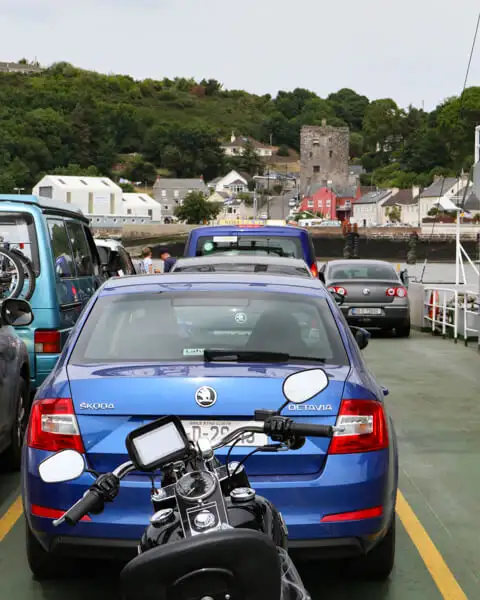
Conclusion
Ireland invites you to discover, slow down and linger. Tintern Abbey in the south-east of the island is a good example of this. Worth seeing, cosy, not overcrowded and – yes, romantic.
From here you can explore the Viking towns of Wexford and Waterford, the Hook Peninsula and Hook Lighthouse, or simply drift along the coast – wherever the wind blows you….
Have fun in the south-east!
More interesting articles for you
THE REBELLIOUS TOWN OF ENNISCORTHY
CAHIR CASTLE – A STAR AMONG THE CASTLES
Picture credits cover picture: Romantic Tintern Abbey, photo: Ulrich Knüppel-Gertberg (www.irland-insider.de, www.ireland-insider.com)